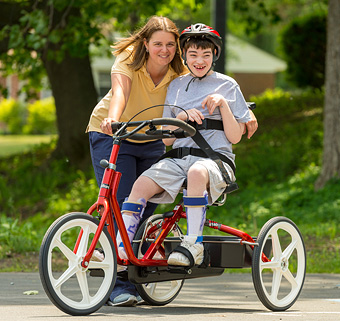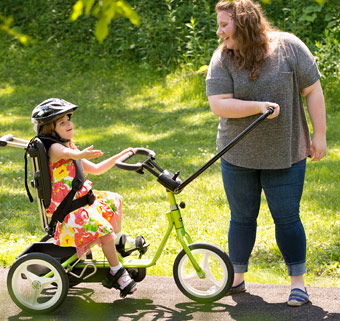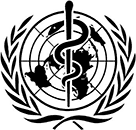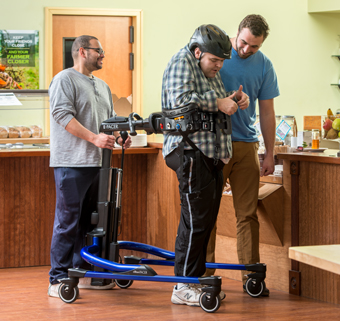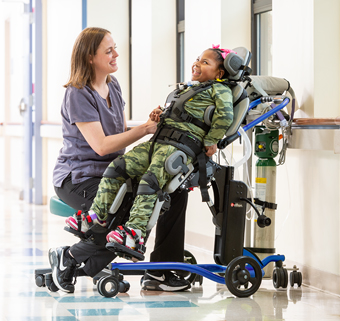Therapeutic Cycling: Evidence for Practice
| July 2008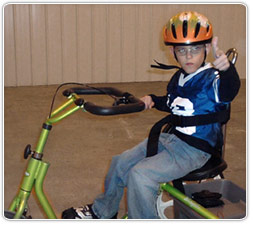 Families and physical therapists value adaptive tricycles for both recreational and therapeutic reasons. But will third party payers understand the medical necessity, and support purchase of this equipment? The following information may be of use to therapists in providing medical justification for adaptive tricycles.
Families and physical therapists value adaptive tricycles for both recreational and therapeutic reasons. But will third party payers understand the medical necessity, and support purchase of this equipment? The following information may be of use to therapists in providing medical justification for adaptive tricycles.
One major problem affecting the function and health of children with Cerebral Palsy (CP) is weakness (1,2) and resultant lack of physical activity. Historically, exercise to promote physical fitness and strengthening were discouraged for children with spasticity, due to the concern that the spasticity and abnormal movement patterns would be enhanced. Current research, however, indicates that resistive exercise does in fact improve strength and function for children with CP. (3,4,5,6)
Inactivity for children with CP may contribute to the development of secondary conditions associated with CP such as joint contractures, osteoporosis, and decreased respiratory and circulatory function. Active exercise and physical fitness can help prevent these secondary conditions. (7) There is increasing recognition of the medical necessity of providing these children with a means of active exercise at school and at home. Parents and family are supportive of these perspectives. (8)
Rifton Equipment manufactures three sizes of an Adaptive Tricycle, designed so that they do not require significant balance or skilled motor ability on the part of the user. For this reason, adaptive cycling is an ideal exercise for children with CP. Tricycling has the potential to improve strength and cardio-respiratory fitness for walking endurance, gross motor function, and health related quality of life.
Research studies focusing on the use of tricycles as an exercise activity for children with CP have resulted in supportive evidence for this intervention, for both muscle activation and function. (9, 10, 11, 12) Further research on adaptive cycling as a medical intervention is needed and is under development. (13)
In order to successfully obtain funding for an adaptive tricycle through medical justification, it is important to prove the medical necessity. One means for this, is to describe it as a therapeutic mobility device, and to detail the therapeutic benefits.
- Regular use of this product can prevent debilitating conditions resulting from immobility such as skin breakdown, contractures, and orthopedic deformities.
- Use of the product supports improved respiration, swallowing, and development of head and trunk control.
- Gross motor practice with this device promotes activation and control of lower extremity muscles in a reciprocal pattern and progression line in patterns similar to walking.
- Long-term benefits include strengthening of anti-gravity muscles, bone and muscle growth, improved eye-hand coordination, opportunity for cognitive growth, and improved self-esteem and social acceptance.
 Here is a link to a sample Letter of Medical Necessity.
Here is a link to a sample Letter of Medical Necessity.
References
-
Wiley ME, Damiano DL. Lower-extremity strength profiles in spastic cerebral palsy. Dev Med Child Neurol.1998;40:100-107. PubMed Link
-
Rose J, McGill KC. Neuromuscular activation and motor-unit firing characteristics in cerebral palsy. Dev Med Child Neurol. 2005; 47:329-336. PubMed Link
-
Fowler EG, Ho TW, Nwigwe Al, Dorey FJ: The effect of quadriceps femoris muscle strengthening exercises on spasticity in children with cerebral palsy. Phys Ther 2001; 81:1215-1223. PubMed Link
-
Damiano DL, Vaughan CL, Abel MF. Muscle response to heavy resistance exercise in children with spastic cerebral palsy. Dev Med Child Neurol.1995;37:731-739. PubMed Link
-
Dodd KJ, Taylor NF, Damiano DL. A systematic review of the effectiveness of strength-training programs for people with cerebral palsy. Arch Phys Med Rehabil. 2002;83:1157-1164. PubMed Link
-
Damiano DL, Kelly LE, Vaughn CL. Effects of quadriceps femoris muscle strengthening on crouch gait in children with spastic diplegia. Phys Ther. 1995;75:658-67. PubMed Link
-
Fowler E, Kolobe T, Damiano D, Thorpe D, Morgan D, Brunstrom J, Coster W, Henderson R, Pitetti K, Rimmer J, Rose J, Stevenson R. Promotion of Physical Fitness and Prevention of Secondary Conditions for Children with Cerebral Palsy: Section on Pediatrics Research Summit Proceedings. Physical Therapy 2007 Nov;87(11):1495-510. PubMed Link
-
Mactavish J B, Schleien S J. Re-injecting spontaneity and balance in family life: parents’ perspectives on recreation in families that include children with developmental disability. Journal of Intellectual Disability Research 2004 Feb;48(Pt 2):123-41. PubMed Link
-
Williams H, Pountney T. Effects of a static bicycling programme on the functional ability of young people with cerebral palsy who are non-ambulant. Dev Med Child Neurol 2007 Jul;49(7):522-7. PubMed Link
-
King EM, Gooch JL, Howell GH, Peters ML, Bloswick DS, Brown DR. Evaluation of the hip-extensor tricycle in improving gait in children with cerebral palsy. Dev Med Child Neurol 1993 Dec; 35(12):1048-54. PubMed Link
-
Ryan MM, Gregor RJ. EMG profiles of lower extremity muscles during cycling at constant workload and cadence. J Electromyography Kinesiol. 1992;2:69-80.
-
Kaplan SL. Cycling patterns in children with cerebral palsy. Dev Med Child Neurol. 1995;37:620-630. PubMed Link
-
Fowler E, Knutson L, DeMuth S, Sugi M, Siebert K, Simms V, Azen S, Winstein C. Pediatric endurance and limb strengthening for children with cerebral palsy (PEDALS) – a randomized controlled trial protocol for a stationary cycling intervention. BMC Pediatrics 2007, 7:14. Complete Text PubMed Link
